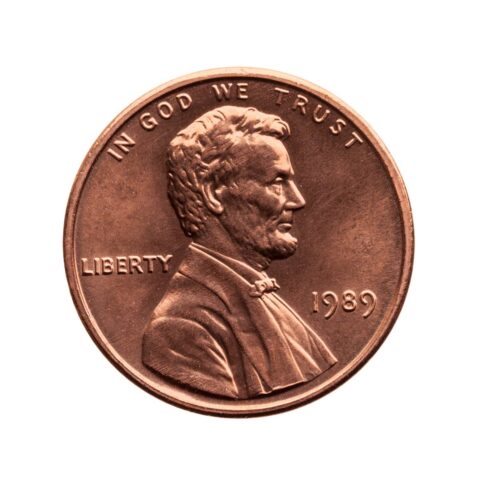How To Grade Pennies
I’ve previously talked about how to get an approximate idea of the grade of a coin — in general.
Now, I’m going to go into more detail about how to determine the exact grades for a specific coin: circulated small cents (pennies).
There are 2 types of U.S. pennies that I will cover here:
- Lincoln cents (1909–present)
- Indian Head pennies (1859–1909)
Here are the various parts of a coin + What the coin grade abbreviations and numbers mean.
We’ll start with the more common Lincoln cent, which is still in circulation today…
NOTE: Listed below are grades for pennies that have the older wheat cent design (1909-1958). Since the obverse is the same on all Lincoln cents, you’ll be able to grade non-wheat pennies (1959-present) by the obverse.
Lincoln Penny Grades

AU-55
- Obverse: Only a trace of wear shows on the highest point of the jaw.
- Reverse: A trace of wear on the tops of wheat stalks. Almost all of mint luster still present.
AU-50
- Obverse: Traces of wear show on the cheek and jaw.
- Reverse: Traces of wear show on the wheat stalks. 3/4 of mint luster still present.
EF-45
- Obverse: Slight wear shows on hair above the ear,on the cheek, and on the jaw.
- Reverse: High points of the wheat stalks are lightly worn, but each line is still clearly defined. Half of the mint luster remains.
EF-40
- Obverse: Wear shows on hair above ear,on the cheek, and on the jaw.
- Reverse: High points of wheat stalks are worn, but each line still clearly defined. A little of the mint luster still remains.
VF-30
- Obverse: Small flat spots of wear on the cheek and jaw. Hair still shows details. Ear and bow tie slightly worn but show clearly.
- Reverse: Lines in the wheat stalks are lightly worn but fully detailed.
VF-20
- Obverse: Head shows considerable flatness. Nearly all detail still shows on the hair and face. Ear and bowtie are worn but bold.
- Reverse: Lines in wheat stalks are worn but plain and without weak spots.
F-12
- Obverse: Some details show in the hair. Cheek and jaw are worn nearly smooth. LIBERTY shows clearly with no letters missing. The ear and bowtie are visible.
- Reverse: Most details are visible in the stalks. Top wheat lines are worn but separated.
VG-8
- Obverse: Outline of hair shows but most details are worn smooth. Cheek and jaw are smooth. More than half of the bowtie is visible. Legend and date are clear.
- Reverse: Wheat shows some details and about half of the lines at the top.
G-4
- Obverse: Entire design well worn with very little detail remaining. Legend and date are weak but visible.
- Reverse: Wheat is worn nearly flat but is completely outlined. Some grains are visible.
AG-3
- Obverse: Head is outlined with nearly all details worn away. Legend and date are readable but very weak and merging into the rim.
- Reverse: Entire design partially worn away. Parts of wheat and motto merged with the wreath.
See photo examples of Lincoln wheat cent grades and Lincoln memorial cent grades.
Indian Head Penny Grades

AU-55
- Obverse: Only a trace of wear shows on the hair above the ear. 3/4 of mint luster remains.
- Reverse: A trace of wear shows on the bow knot. 3/4 of mint luster still present.
AU-50
- Obverse: Traces of wear show on hair above the ear and curl to right of ribbon.
- Reverse: Traces of wear show on the leaves and bow knot. Half of the mint luster is still present.
EF-45
- Obverse: Wear shows on hair above ear,curl to right of ribbon, and on the ribbon end. All of the diamond design and letters in LIBERTY are very plain.
- Reverse: High points of the leaves and bow are lightly worn. Traces of mint luster still show.
EF-40
- Obverse: Feather well defined and LIBERTY is bold. Wear shows on hair above ear, curl to right of ribbon, and on ribbon end. Most of the diamond design shows plainly.
- Reverse: High points of the leaves and bow are worn.
VF-30
- Obverse: Small flat spots of wear on tips of feathers,ribbons,and hair ends. Hair still shows half of details. LIBERTY lightly worn but all letters are sharp.
- Reverse: Leaves and bow worn but fully detailed.
VF-20
- Obverse: Headdress shows considerable flatness. Nearly half of the details still show in hair and on ribbon. Head slightly worn but bold. LIBERTY is worn but all letters are complete.
- Reverse: Leaves and bow are almost fully detailed.
F-12
- Obverse: 1/4 of details show in the hair. Ribbon is worn smooth. LIBERTY shows clearly with no letters missing.
- Reverse: Some details visible in the wreath and bow. Tops of leaves are worn smooth.
VG-8
- Obverse: Outline of feather ends shows but some are smooth. Legend and date are visible. At least 3 letters in LIBERTY show clearly but any combination of 2 full letters and parts of 2 others are sufficient.
- Reverse: Slight detail of the wreath shows but the top is worn smooth. Very little outline shows in the bow.
G-4
- Obverse: Entire design well worn with very little detail remaining. Legend and date are weak but visible.
- Reverse: Wreath is worn flat but completely outlined. Bow merges with wreath.
AG-3
- Obverse: Head is outlined with nearly all details worn away. Legend and date readable but very weak and merging into rim.
- Reverse: Entire design partially worn away. Bow is merged with the wreath.
The Bottom Line…

It takes a bit of time and experience to consistently grade coins accurately, but you’ll never get there if you don’t start somewhere.
Hopefully you’re able to grade your Lincoln cents and Indian Head pennies yourself now.
Grab a coin magnifier and a copy of the U.S. Coin Grading Standards book. Then, watch this video to see how to grade coins yourself at home:



